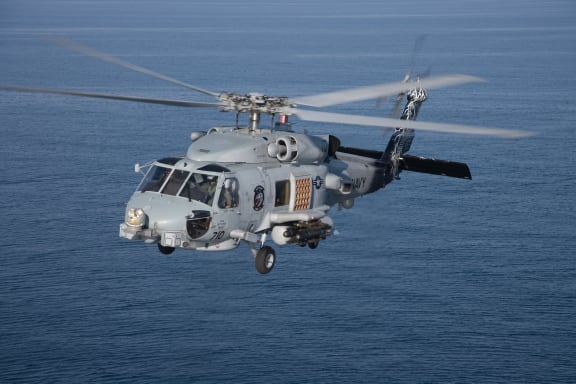WASHINGTON — The Navy is nearing a decision to OK production for a fleet electronic protection system, according to the system’s manufacturer.
The Advanced Off-Board Electronic Warfare sensor pod will be outfitted on MH-60 Sierra and Romeo helicopters to extend ships’ line-of-sight limitations in the electromagnetic spectrum.
“The technical data has been submitted and we’re square there, and we expect a final decision in the next 30 to 60 days timeline and then expect immediately, shortly after that, to move into low-rate initial production,” Joe Ottaviano, director of maritime and airborne cyber and electronic warfare at Lockheed Martin, told C4ISRNET regarding an impending Milestone C decision from the Navy.
The system can work in coordination with the fleet for extended electronic warfare protection, but can also autonomously work in a denied environment, Ottaviano, said.
While it has undergone some flight tests, more testing must be done.
While Lockheed worked with the Navy on the program, Ottaviano said, they have learned how the system interacts with the environment and seen ancillary capabilities not specifically intended during initial design.
“Whenever we roll out new systems … you quickly learn it does a lot of things, capability you didn’t actually plan for,” he said.
He pointed to a similar case with the Surface Electronic Warfare Improvement Program, or SEWIP Block II, which Lockheed is providing to the Navy for ship-based electronic protection.
When SEWIP was being installed on ships, Ottaviano said, the firm noticed new capabilities it didn’t initially realize.
Lockheed recently delivered the 100th Block II system to the Navy.
Ottaviano praised the ability to deliver over-the-air updates to the system, allowing for the insertion of new software and firmware as needed to address new threats. Additionally, there will be a hardware refresh this year for the program.
Continued EW investment
Ottaviano said Lockheed’s Spectrum Convergence business is using open architecture and investments to create offerings across the services, meaning architectures built for sea-based platforms are now used for ground and airborne platforms.
He said Lockheed is also considering greater investments in artificial intelligence and machine learning that would provide recommendations to operators and additional analysis of the electromagnetic environment.
Moreover, it is meant to help operators assess the success of a certain effect.
“Let’s say I’m providing an effect through whether it’s cyber, EW, converged effect. How good am I doing with that effect? That’s always been something that’s been somewhat of a challenge for passive and electronic warfare systems,” he said. “If I provide an EA effect or a cyber effect, how do I know it’s working?”
“That’s another place we’re investing, and [AI and machine learning come] in because you can see behavioral changes in the target from what you’re providing that effect, and it’s faster than an operator can see,” Ottaviano added. “That system can learn and say: ‘Hey, this worked, this didn’t, do this next time, don’t do that next time.’ Those are the kind of capabilities we’re doing now.”
Mark Pomerleau is a reporter for C4ISRNET, covering information warfare and cyberspace.








